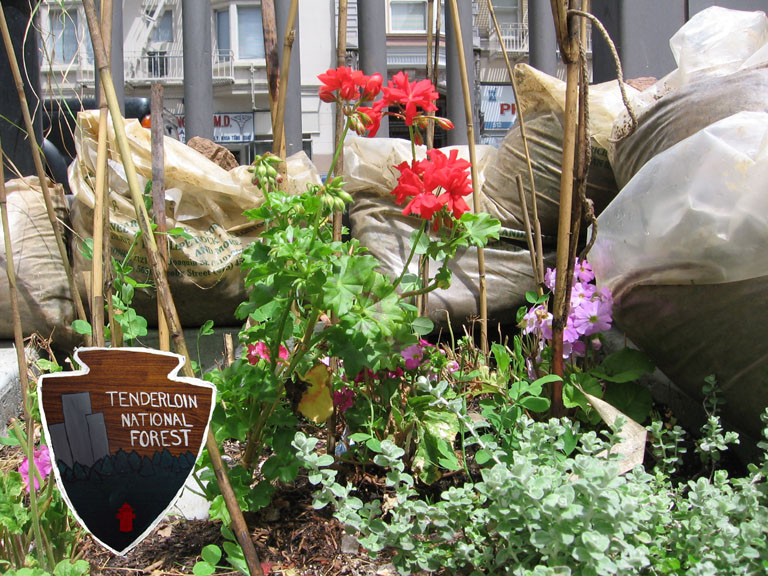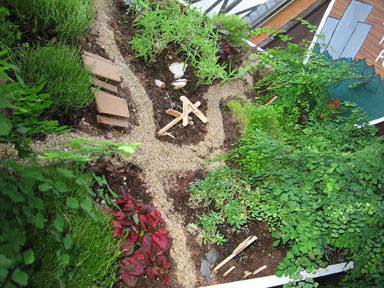
The Tenderloin National Forest
a city forest in san francisco

The Tenderloin National Forest is located in Cohen Alley off Ellis Street in the San Francisco Tenderloin next to the 509/Luggage Store Gallery Annex. The Tenderloin has a very diverse population and is home to numerous non-profit organizations that provide housing, meals, health and other services. More Images
The high concentration of apartment buildings in the Tenderloin gives it the densest population (people per square mile) in the city, and also the highest proportion of families and children. It is also one of the poorest, with a median family income of around $20K, a figure that is less half the overall city average. The area has a large number of immigrants from Asia, Southeast Asia and Latin America, and the 2004 demographic summary stated that the Tenderloin is home to the city's entire Cambodian population.
The Tenderloin National
Forest was created to address the lack of green space in this
neighborhood.
The Forest is intended to be an inspiration and model
for others to attempt gardening in the inner city. People are welcome to come by the
Forest to look, and if the gate is open (when the gardeners
are there), to see the plants and exchange ideas about forests and flora in the city.
WHY A NATIONAL FOREST?
A National Forest as a category is
traditionally a preserve set aside and protected for a future. This land is held in trust for the
public by the state, with the implicit idea this preserve is there for the public, the
people inhabiting the state. The USDA Forest Service
was established in 1905 as an a agency of the US Department of Agriculture. From their website, "The
Forest Service manages public lands in national forests and grasslands, which encompass 193 million
acres. As manager of "public" lands, the Forest Service is in the role of negotiating
meanings of "public-ness" itself, raising the question of who is to benefit from particular ways that land
is cared for or utilized, and what principles guide these decisions?
PUBLIC: The notion of "public" is noted as being an impossible one in the United States. What then constitutes or provides for public desires and protection in the case of the National Forests? Often "public interest" is defined using the same parameters as in urban eminent domain decisions, i.e., "highest and best use" is dictated by highest potential for capital extraction. The question of who the public is, and who makes decisions for a public trust, and who might benefit through a process of self-determination regarding access to land and the promotion of other definitions of benefit is not equally open to all public entitites.
HERITAGE: In some areas, the National Forest is also a site for reflection upon history and legacy. This has a part in producing nationalistic memory and ideologies and in grooming citizens in their roles as nation builders. This sense of heritage is produced as an experience and is mediated through an experience which is touristic. Ellis Island in New York Harbor is another site for the performance of heritage and immigration history, a private organization co-operated with the National Park Service. San Francisco has long been an entry point for immigrants from the east; once it was Chinatown or the coastal areas of the city that received these immigrants, but since the earthquake, it has been the capacious Tenderloin.
AURA: National Parks are unique sites that cannot be easily transposed, transported, translated or represented in another location. They are, with the exception of the SF Presidio, which is a uniquely urban part of the US Park Service generally far away from the largest part of US populations. The Tenderloin National Forest, like the Backyard Nature Reserve, makes available unique sites of biological diversity available and accessible to portions of the population that do not own cars or have the extra cash or time to get away to Yosemite for the weekend.

TOURISTIC EXPERIENCE: Gift kiosks, an aesthetics of exhibitionism etc are part of this mediation, indexing the original auratic experience of the visitor, and producing synechdotal trinkets that allow you to take a piece of the rock home with you.
DISBURSEMENT OF MONEY: A National Park in an urban district allows for new distributions between urban and rural areas (2006 marks the first year the populations are more urban than rural), yet many urban dwellers have not got the means to provide for adequate housing in an urban economy that fosters unbridled gentrification. Like the old private farms and homesteads that have been grandfathered into many rural National Parks, which benefit from new streams of Federal money for roads and communication, the Tenderloin National Forest could benefit from Federal subsidizations for the maintenance of a heterogenously "wild" zone in the midst of the urban jungle.
EMPLOYMENT: The Tenderloin is known for its hardy outdoorsmen; people who have learned to live outside in all kinds of weather as an adaptation to San Francisco's through-the-roof housing prices. Could a semi-wild Urban National Forest sited in the Tenderloin provide new forms of employment and housing for people who have been cast outside of the economic security associated with neo-liberal civilization?
MONUMENT: Many heritage sites have additional protections due to their It is protected by a government at the state or federal level. You wouldn't normally expect to see such a monument in an inner city. implication they should be also protected by the individuals (fires?) (homeless populations)as well as questions about national heritage and excluded populations.
MONUMENTALIZATION: Even if the preserve is not a monument itself, there is a sense of the monumental; the biggest, longest, oldest and most out of the way. Normally one has to drive a long distance to go. One also has to have the luxury of time in order to go. What are the vacation habits of Americans? How much does the Tenderloin travel?
SAN FRANCISCO'S GOLDEN GATE PARK and the Tenderloin: An ideal extension of the Tenderloin National Forest could be realized by creating a green swath that runs from the TNF into Golden Gate Park, thereby creating a green swath for humans, animals and plants that runs from downtown all the way to the Pacific Ocean.
|
| |

|
How did this dirt get here? In 2005 Sarah Lewison and her San Francisco State Art CityLab class began to fill dirt into the street, which took quite a bit of effort, but this manifestation was invited through the prior mighty inspiration of Darryl Smith and Laurie Lazar who started planting trees there and closed off the alley with a gate. TNF continues to be created and recreated by the visions of a great many people in the neighborhood, but is especially fostered and supported by the Luggage Store Gallery, directed by Darryl Smith and Laurie Lazer. Such are the things that happen before and after us. Maquette and title of the Tenderloin National Forest by Marco Crescenti |